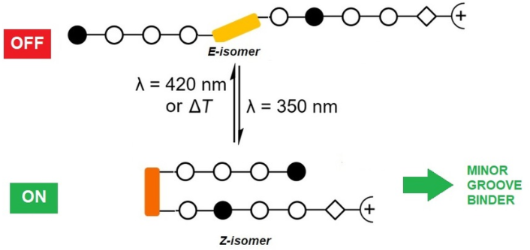Search results
Search for "netropsin" in Full Text gives 4 result(s) in Beilstein Journal of Organic Chemistry.
Photocontrolled DNA minor groove interactions of imidazole/pyrrole polyamides
Beilstein J. Org. Chem. 2020, 16, 60–70, doi:10.3762/bjoc.16.8

- . A major breakthrough concerning selective small DNA-targeting molecules was the use of pyrrole/imidazole hairpin polyamides. They are conceptually derived from the natural products netropsin and distamycin A, which selectively bind to particular sequences of the DNA duplex [2][3][4]. Covalent
An overview of recent advances in duplex DNA recognition by small molecules
Beilstein J. Org. Chem. 2018, 14, 1051–1086, doi:10.3762/bjoc.14.93

- particular, we cover the advances made in DNA minor groove recognition using new analogues and derivatives of classical minor groove binders such as distamycin, netropsin, polyamides, bisbenzimidazoles and organic cations. We have also included new intercalating agents as well as major groove binding ligands
- group of the guanine base [19]. 2.1. Polypyrroles and polyamides The first two MGBs discovered were distamycin A and netropsin (Figure 3). These naturally occurring molecules are characterized by repeating N-methylpyrrole units with one or more positively charged nitrogen atoms at the end. Their concave
- as inhibitors of Werner and Bloom syndrome helicases and dual topoisomerase I/II inhibitors [37][38]. In order to improve DNA binding affinity and sequence specificity with reduced side effects, a series of synthetic hybrid molecules derived from distamycin and netropsin was synthesized and their
Fluorescent nucleobase analogues for base–base FRET in nucleic acids: synthesis, photophysics and applications
Beilstein J. Org. Chem. 2018, 14, 114–129, doi:10.3762/bjoc.14.7
- distance window of opportunity than external fluorophores, and, thus, have the potential to facilitate better structure resolution. Netropsin DNA binding and the B-to-Z-DNA transition are examples of structure investigations that recently have been performed using base–base FRET and that are described here
- . Keywords: B-to-Z-DNA transition; fluorescent base analogues; FRET; netropsin; nucleic acid structure and dynamics; quadracyclic adenines; tricyclic cytosines; Z-DNA; Review Introduction The importance of nucleic acid structure and dynamics in the understanding of vital processes in living organisms has
- established minor groove binder netropsin [25]. Netropsin is an archetypal minor groove ligand that binds short (4–5 bp) AT-rich sequences [74][75][76]. In our investigation we first measured the FRET efficiencies, using both steady-state and time-resolved emission, between qAN1 and qAnitro separated by 2–13
Polarization spectroscopy methods in the determination of interactions of small molecules with nucleic acids – tutorial
Beilstein J. Org. Chem. 2018, 14, 84–105, doi:10.3762/bjoc.14.5

- ligand aggregates binding to polynucleotides (Figure 2). Many naturally occurring small molecules owe different biological activities due to aggregation, for instance, the close analogs netropsin (the single molecule in the DNA minor groove) and distamycin (the dimer in DNA minor groove) [13]. In



































































